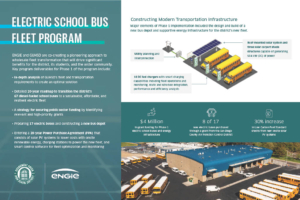ALIQUIPPA, Pa. and HOUSTON, Sept. 20, 2023 /PRNewswire/ — GetBlok Farms© has entered into a two-year renewable energy agreement with ENGIE Resources LLC, a subsidiary of ENGIE North America (ENGIE). This renewable energy purchase includes Renewable Energy Credits (RECs) from the Priddy Wind Project (Mills County, Texas). GetBlok Farms© will receive RECs to match the forecasted consumption for its hydroponics farm in West Aliquippa (PA).
The Green-e® certified RECs in this agreement are determined by the Center for Resource Solutions to be independently verified to represent the environmental benefits of one MWh of renewable energy. Over the term of this agreement, the RECs will equal 100% of GetBlok Farms© demand and avoid the equivalent CO2 emissions from 343,730 pounds of coal burned, or the greenhouse gas emissions avoided by 106 tons of waste recycled instead of landfilled.*
“Sustainability drives the core of our operations,” said Vinnie Lima, Managing Member at GetBlok Farms. “Our approach for hyper-local and highly sustainable farming methods must address the energy consumption in hydroponic farms. As a core piece of our sustainability commitment, we are delighted to leverage wind-generated Green-e® power from the Priddy Wind Project designed, developed and operated by ENGIE.”
The Priddy Wind Project is a 300 MW asset with 63 turbines that can produce electricity with wind speeds as low as 6.7 mph. The project is located 150 miles southwest of Dallas and commenced commercial operations in February 2022.
“Not only is this one of the first customer announcements for renewable energy from the Priddy Wind Project, it is one of the first hydroponic farms in our portfolio of customers,” said Taymur Bunkheila, director of sustainability solutions and energy+ initiatives at ENGIE Resources. “We are proud to bring the benefits of planet-friendly power to an operation with such a noble cause.”
*According to EPA Greenhouse Gas Equivalencies Calculator.
About GetBlok Farms
GetBlok Farms utilizes Controlled Environment Agriculture (CEA), growing over 2.5 acres of fresh produce in only 320 square feet. Through a state-of-the-art CEA system, we are able to consume 97% less water than traditional farming, while utilizing no pesticides or herbicides. By “moving farms, not food”, we are able to achieve an astounding reduction of over 1500 miles in transportation, leading to a substantial decrease in CO2 emissions and waste. Located in Aliquippa, Beaver County, Pennsylvania, GetBlok Farms is deeply rooted in community involvement and economic development in disadvantaged food deserts.
About the ENGIE Group
The ENGIE Group (made up of ENGIE S.A. and its subsidiaries and affiliates) is a global leader in low-carbon energy and services. With its 96,000 employees, its customers, partners and stakeholders, the Group is committed to accelerate the transition toward a carbon-neutral world, through reduced energy consumption and more environmentally-friendly solutions. Inspired by its purpose (“raison d’être”), ENGIE reconciles economic performance with a positive impact on people and the planet, building on its key businesses (gas, renewable energy, services) to offer competitive solutions to its customers. ENGIE S.A. (ENGI), is listed on the Paris and Brussels Stock Exchanges. In North America, ENGIE companies have delivered integrated, innovative energy solutions to public and private organizations for nearly half a century. We employ approximately 3,000 people focused on enabling our customers to become more sustainable and achieve their decarbonization targets through expert project delivery and competitive solutions. For more information on ENGIE in North America, please visit our LinkedIn page or Twitter feed, https://www.engie-na.com/ and https://www.engie.com.
SOURCE ENGIE Resources
